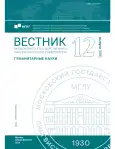TYPOLOGY OF TRANSLATION TRANSFORMATIONS IN THE RUSSIAN-GREEK PAIR
- Authors: Grishin A.Y.1
-
Affiliations:
- Moscow State Linguistic University
- Issue: No 12(893) (2024)
- Pages: 32-39
- Section: Linguistics
- URL: https://journal-vniispk.ru/2542-2197/article/view/291712
- ID: 291712
Cite item
Full Text
Abstract
The purpose of the study is to identify the underlying processes of restructuring the morphology of the verb, the syntax of the verbal node and changes in the nominal domain, leading to the emergence of translation transformations. The study uses historical-comparative, diachronic, distributional and other methods. The factual material is the National Corpus of the Russian Language and four arrays of texts in Greek, amounting to 30-40 million words. As the result of the analysis, it was established that translation transformations are associated with the tendencies of analyticity in the Greek language.
About the authors
Alexey Yulievich Grishin
Moscow State Linguistic University
Author for correspondence.
Email: grishinaj@yandex.ru
PhD, Associate Professor at the Department of the Scandinavian, Dutch and Finnish Languages Faculty of Translation and Interpreting, Moscow State Linguistic University
Russian FederationReferences
- Danilina, N. I. (2012). Morfonologicheskie sistemy v sinhronii i diahronii: na materiale neblizkorodstvennyh yazykov = Morphonological systems in synchrony and diachrony: based on the material of non-closely related languages: abstract of Senior Doctorate in Philology. Saratov. (In Russ.)
- Karabanova, O. O. (2000). Perevodcheskie transformacii kak ponyatie i yavlenie = Translation transformations as a concept and phenomenon: abstract of PhD in Philology. Moscow. (In Russ.)
- Chernysheva, M. I. (1994). Problema vliyaniya grecheskogo yazyka na yazyk perevodnyh pamyatnikov v drevnerusskoj knizhnosti = The problem of the influence of the Greek language on the language of translated monuments in ancient Russian literature: abstract of Senior Doctorate in Philology. Moscow. (In Russ.)
- Shcheglova, N. V. (2014). The use of translation transformations (based on the works of N. Kazantzakis). Philological sciences. Questions of theory and practice. Tambov: Gramota, 6, 217–220. (In Russ.)
- Letuchij, A. B. (2013). Tipologiya labil’nyh glagolov = Typology of labile verbs. Moscow: Yazyki slavyanskoj kul’tury. (In Russ.)
- Dixon, R. M. V., Aikhenvald, A. Y. (2000). Changing Valency: Case studies in transitivity. Cambridge University Press.
- Tonnet, H. Histoire du grec moderne: la formation d‘une langue. Paris: L’Asiathèque, 2003. = Tonnet, H. (2003). History of modern Greek: the formation of a language. Paris: The Asiathèque.
- Palmer, L. R. (1980). The Greek Language. University of Oklahoma Press.
- Μπαμπινιώτης, Γ. Συνοπτική ιστορία της ελληνικής γλώσσας. Αθήνα, 2002 = Babiniotis, G. (2002). A Brief History of the Greek Language. Athens.
- Tenier, L. (1988). Osnovy strukturnogo sintaksisa = Basics of structured syntax: translation from French by I. M. Boguslavsky and others. Moscow: Progress. (In Russ.)
- Alexiadou, A., Doron, E. (2012). The syntactic construction of two non active Voices: Passive and Middle. Journal of Linguistics, 48(1), 1–34.
- Λαβίδας, Ν. Μεταβολές στη μεταβατικό τητα του ρήματος της Ελληνικής: διδακτορική διατριβή. ΕΚΠΑ. Αθήνα, 2007 = Lavidas, N. (2007). Changes in transitivity of the Greek verb: PhD. EКРA. Athens.
- Goryachkin, A. R. (2023). Causative constructions in the Italian linguistic picture of the world. Vestnik of Moscow State Linguistic University. Humanities, 12(880), 18–23. (In Russ.)
Supplementary files










